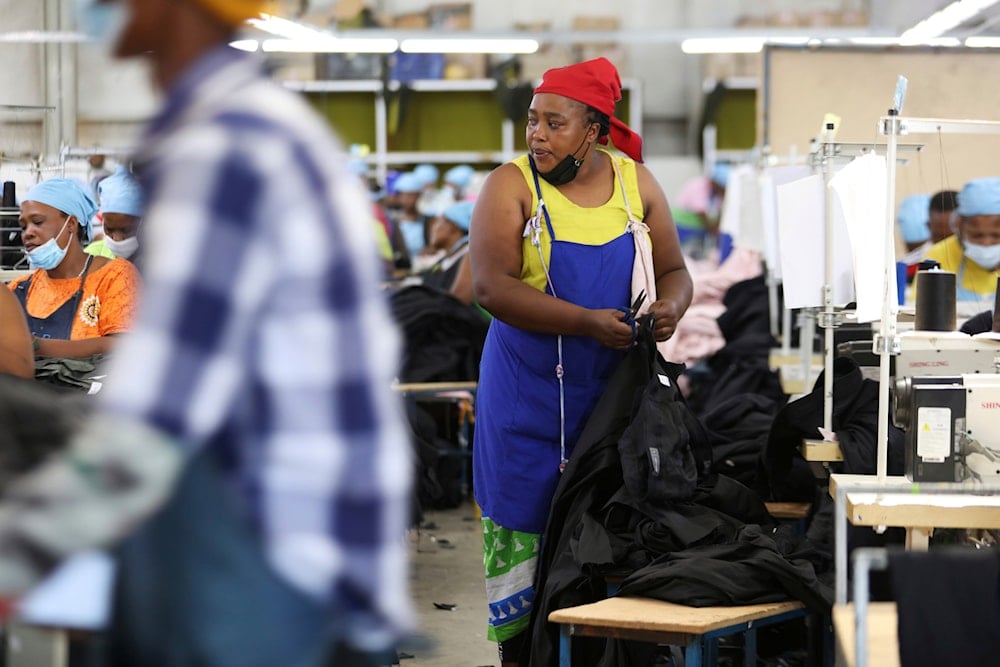US tariffs cripple Lesotho’s garment industry: FT
Lesotho’s garment industry faces collapse as Trump’s tariffs and aid cuts undermine AGOA trade preferences and threaten the country’s fragile economy.
-

Women work in a garment factory in Maseru, Lesotho, on February 24, 2022. (AP)
An opinion piece published by the Financial Times (FT) on Thursday suggests that Lesotho, once a beneficiary of extensive US trade preferences and aid, is now facing the collapse of its fragile garment industry under the weight of Donald Trump’s sweeping tariffs and cuts to development assistance.
Alan Beattie, the author, mentioned that in the early 2000s, the United States extended trade and aid benefits to Lesotho, a small, landlocked southern African kingdom, as part of the African Growth and Opportunity Act (AGOA), allowing Lesotho to export garments to the US using imported fabrics.
Lesotho then became a model for AGOA’s potential. Its textile sector flourished, aided further by then-President George W. Bush’s PEPFAR program for HIV/AIDS relief and international private initiatives like Gap’s Product Red campaign.
Beattie argues that Trump’s trade policies, marked by extreme tariffs and a dismantling of the US foreign aid budget, are inflicting severe damage on low-income garment exporters. He added that Lesotho faces the possibility of 50% duties on its exports to the US, suspended only until August 1.
For a country with no significant trade surplus and no competitive threat to US industries, such tariffs are viewed by experts as disproportionate and punitive.
Lesotho as a case study of LDC vulnerability
Lesotho’s situation reflects broader vulnerabilities among least developed countries (LDCs) whose growth strategies are tightly bound to preferential access to developed markets.
Beattie explains that due to Lesotho’s geography, the country lacks direct access to ports and suffers from weak infrastructure. Its garment sector initially attracted foreign investors, many of them Taiwanese, thanks to low labor costs and preferential access to US markets.
However, the limited integration of these operations into the domestic economy has made it easy for companies to withdraw when faced with external pressures.
Broader impact on developing countries
Other garment-producing LDCs such as Cambodia and Bangladesh are also affected by the pressure of changing trade dynamics, albeit from stronger positions.
Cambodia and Bangladesh are on track to graduate from LDC status, which will reduce their eligibility for preferential schemes. While they too face rising US tariffs, 35% and 36% respectively, their more diversified export bases and stronger industrial ecosystems give them better odds of weathering the storm, according to the report.
According to Beattie, Brussels has previously leveraged trade access to push countries to accept failed asylum seekers, policies critics argue are disconnected from trade itself. In contrast, the UK has recently made its preference schemes more generous post-Brexit, offering an alternative model.
Lessons for low-income export economies
Lesotho’s current crisis serves as a cautionary tale for other low-income countries pursuing export-led growth through trade preferences.
Experts warn that building a national development strategy around the goodwill of major powers, particularly through unilateral trade schemes, creates strategic exposure. However, when these preferences are withdrawn or politically repurposed, the consequences can be devastating.
Beattie stressed that while international trade remains a key path to development, the case of Lesotho underscores the need for infrastructure investment, domestic supply chains, and a diversified export base, emphasizing that without it, countries risk being stranded when foreign policies shift.

 3 Min Read
3 Min Read










